
Afghanistan is a geographically landlocked country in Southern Asia. The Central Asian Republics of Turkmenistan, Uzbekistan and Tajikistan lie along its northern border, Iran lies to the west, Pakistan to its east, and China at its easternmost Hindu Kush mountainous peak along the Wakhan corridor. The Hindu Kush mountains, the westernmost part of the Himalayan range, dominates the rugged terrain and runs across the country from east to west. The Pamir Mountain, extend from the West of Afghanistan into Tajikistan, China, and Kashmir. High passes are found in both of these mountain ranges and they form a strategically important network for traders, invaders and fighters.
The most famous historical passes were the Khyber Pass and the Kotal-e Lataband pass, both leading from Kabul to Pakistan, and the Kotel-e Salang pass, linking Kabul to northern Afghanistan. The climate is extremely harsh with bitter cold winters and blazing hot summers. The region also lies on a major tectonic fault line and thus is prone to many earthquakes. In summary, it is a challenging environment for its inhabitants as well as the countless invading foreign armies who have failed to subjugate the country.
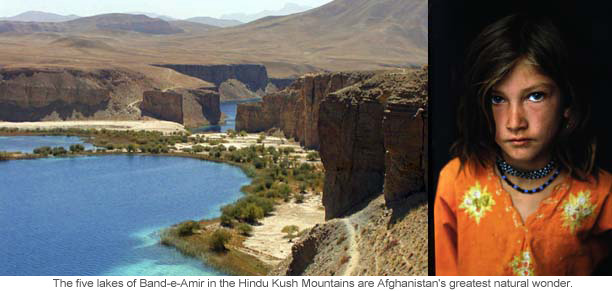
AREA:
251,825 sq miles
(slightly smaller than Texas)
POPULATION:
32,738,376 (July 2008 est.)
CAPITAL: Kabul with approx population 2 million
Other major cities are Ghazni, Jalalabad, Herat, Kandahar, and Mazar-e Sharif.
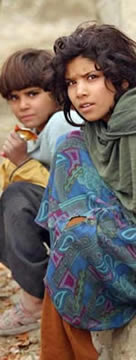
NATURAL RESOURCES: Natural gas, petroleum, coal, cooper, chromite, talc, barites, sulfur, lead, zinc, iron ore, salt, precious and semiprecious stones Land use: Arable land 12% Permanent pastures 46% Forests and woodland 3% Other 39%. Agricultural products: opium, wheat, fruits, nuts, wool, mutton, sheepskins, lambskins.
INDUSTRIES: small-scale production of textiles, soap, furniture, shoes, fertilizer, cement, handwoven carpets, natural gas, coal, cooper.
Afghanistan’s geographic position has made it one of the trading and migration crossroads of Central Asia. Communities with separate religions, languages, and ethnic backgrounds have lived side by side for generations. Afghanistan has seen Hindu, Buddhist and Zoroastrian kingdoms flourishing in its territory in past centuries and it still remains a country of dynamic diversity. It is a country divided into many tribal and ethnic groups. One aspect of life which unites almost all Afghanis, however, is the religion of Islam. Although there are sectarian differences, and variations in the practice of the religion, Afghanis are virtually all Muslims.
An estimated 80%of the population is Sunni Muslim while 19% is Shia Muslim.
Ethnic groups are Pashtun 42%, Tajik 27%, Hazara 9%, and Uzbek 9%, Aimak 4%, Turkmen 3%, Baluch2%, Nuristani and Kizibash 4%.
Pashtun: largest ethnic group, mostly farmers and Sunni Muslims Tajik: live mostly in the northeast, second largest ethnic group, mostly Sunni Muslims Hazara: live in the Hindu Kush mountains, primarily Shiite Muslims Uzbek: live mostly along the northern border, mostly Sunni Muslims.
Pashto and Dari (Afghan Persian) are Afghanistan’s official languages. Dari is spoken by over 50% of the population and Pashto is spoken throughout Kabul and eastern and southern Afghanistan. Many Afghans are multi-lingual. Tajik and Turkic languages are spoken widely in the north. Smaller groups throughout the country also speak more than 70 other languages and numerous dialects.
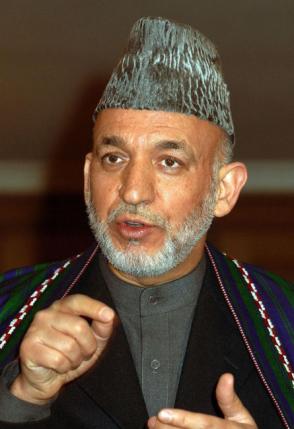
GOVERNMENT
The Constitution of Afghanistan provides for the presidential and parliamentary elections. President Hamid Karzai earned the majority of votes during the Presidential election of 2004 and has since worked to lay the foundation of a democracy in his 5 year term with the possibility for one additional term. In 2005, the Parliamentary elections were held for the Wolesi and Meshrano Jirgas, comprising the upper and lower houses of Parliament for which each Parliamentariam would serve a 5 year term. Afghanistan is a country of councils; the Loya Jirga (Grand Council) and local shuras have been contributing, for centuries, to the political landscape of Afghanistan. Afghans are thus accustomed to working through these councils towards building consensus. The parliament consists of two chambers: the Wolesi Jirga (The Lower House) and the Meshrano Jirga (the Senate); as well as Provincial Councils; District Councils; Village Councils; and Municipal Councils and elected mayors.
The Constitution mandates that two women be elected from each of the 34 provinces of Afghanistan, to the lower House of Parliament (wolesi jirga). This means that at least sixty-eight of the 249 (or 27%) of lower house seats must be occupied by women, placing the Afghan legislature in the top 20 when it comes to the worldwide comparison and considerably higher than the United States or the United Kingdom which have 15% and 18%, respectively. The Senate (meshrano jirga) consists of 102 members. Senators are elected appointments and indirect elections. Two thirds are elected. The President selects the remaining one third for a period of five years. Appointees by the president shall include two representatives of the disabled, and two representatives from the kuchis or nomads and 17 women.

Persia reestablished control in the 6th century only to lose it briefly during the Arab invasions in the 7th century which introduced Islam in the region. The establishment of the Islamic Ghaznavid dynasty(962-1140) began the process of uniting the Afghan tribes and converting them to Islam. This dynasty, which flourished for two centuries, produced a number of Afghan heroes. The exploits of Mahmud of Ghazni, who invaded and conquered parts of India, as well as the intellectual writings of the great scientist, Ibn Sina (Avicena), are still talked about in present day Afghanistan. The Ghaznavid dynasty was destroyed in the 12th century by the Ghorids from Central Afghanistan, whose brief conquest was ended by the 1219 invasion by Genghis Khan’s Mongol armies. In addition to leveling a number of cities which resisted his armies, Genghis destroyed the ancient Karez (underground) irrigation systems, thus turning fertile land into permanent deserts. The countryside has never recovered from this destruction.
The collapse of the Mongol empire early in the 14th century, allowed descendants of the Ghorids to reassert control in Afghanistan and in 1370 Timour-i-lang (Tamerlane) came to power and began invasions of India and surrounding territories. Tamerlane’s empire in turn was destroyed by Babur, who founded the Mughal dynasty and seized control of Kabul in 1504. The ruler, Emperor Babur, had his capital in Kabul in 1512 bringing Afghanistan to the heights of power but as the Mughals extended their dynasty into India, Afghanistan went from being the center of the empire to merely a peripheral part of it. As in the previous dynasties, the Mughals experienced a series of uprising and revolts by tribal Afghans. These revolts produced several national heroes such as Bayazid Roshan, an Afghan intellectual who in the middle of the 16th century led the revolt against the Moghuls and was martyred, and the warrior-poet, Khushhal Khan Khattak who led a revolt against the Mughals in the mid 17th century. The Persian Safavid dynasty ruled Western Afghanistan and parts of the Southwest in the 17th century and 18th centuries, although their control was always tenuous and revolts frequent; at one point, in the early 18th century, they were kicked out of Kandahar and the Afghans invaded Persia!
EMERGENCE AS A STATE
The creation of modern Afghanistan began with the assassination of Nadir Shah (a Persian) who ruled much of Afghanistan and Persia, and the rise of an Afghan army under the leadership of Ahmad Shah Abdali who proclaimed the Durrani dynasty and established a united Afghan State beginning in 1747. The Durrani Empire was a larger state that included modern Afghanistan, Pakistan, parts of eastern Iran and western India. It was a monarchy rule from 1747 until 1823 by Ahmed Shah Durrani and his descendants. They were from the Sadozai line of the Abdali or Durrani group, making them the second Pashtun rulers from Kandahar, Afghanistan. It was under the leadership of Ahmad Shah that the nation of Afghanistan began to take shape following centuries of fragmentation and exploitation. Ahmad Shah conquered large areas of Afghanistan and Pakistan, creating the largest Muslim empire of the late 18th century. The descendants of Ahmad Shah continued to expand and rule although they faced continuous revolts from various tribes as well as invasions from Persia and eventual chaos and anarchy.
Throughout the 19th century Afghans fought against British forces. In 1826, Dost Muhammad became the emir (king) at a time when Great Britain and Russia were struggling for control of Central Asia. The British didn’t want Dost Muhammad to remain ruler of Afghanistan, preferring a weaker leader whom they could control. The British attempt to dethrone Dost Muhammad led to the First Anglo-Afghan War (1838-1842). While the campaign was initially a military success for the British, the Afghans were successful in returning Dost Muhammad to the throne. The Second Anglo-Afghan War (1878-1879) stemmed from disagreements about the borders of Afghanistan. Faced with an overwhelming British force, the Afghans signed the Treaty of Gandamak in 1879. According to the terms of the treaty, Afghanistan surrendered virtually all control of their foreign affairs.
In 1880, Abdur Rahman Khan assumed the Afghan throne. During his two decades of rule, he attempted to modernize Afghanistan by weakening the tribalism that was inherent in Afghan society. The twenty-one year reign of Abdur Rahman Khan was an important period for the consolidation of a modern state marked by efforts to modernize and establish control of the kingdom. The borders of Afghanistan were established in 1893 through negotiations with the British and provincial governments emerged, taking the place of clan rule.
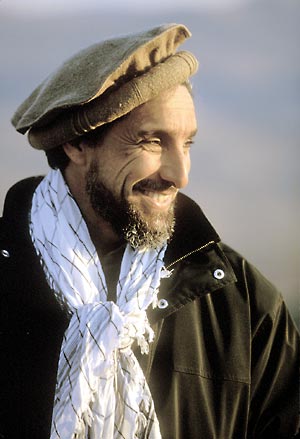
MODERN HISTORY
In 1919, Afghanistan gained independence from British occupying forces. From 1919-1973 Afghanistan modernized and built extensive infrastructure with the assistance of the international community. This period of relative stability ended in 1973 when King Zahir Shah was overthrown while away in Europe.
In 1978 and 1979, a number of coups brought to power a communist government that drifted increasingly toward the USSR, ending with a Soviet puppet government in Kabul led by Babrak Kamal. In addition to the significant upheaval within government circles, popular opposition to government reforms led to the rise of an indigenous Afghan resistance group called the mujahadeen . In order to combat this guerrilla insurgency, the Soviet Union sent troops into Afghanistan; this signaled the beginning of the Afghanistan War (1979 – 1989). The Soviets made little progress in breaking the will of the mujahadeen fighters. With the help of the United States, Afghans successfully resisted the occupation. On February 15, 1989 the last Soviet soldier retreated across Afghanistan’s northern border. As hostilities ceased, more than a million Afghans lay dead and 6.2 million people, over half the world’s refugee population, had fled the country.

The Soviet withdrawal in 1989 weakened the communist government of President Najibullah, leading to his ousting in April 1992. An interim president was installed and replaced two months later by Burhanuddin Rabbani, a founder of the country’s Islamic political movement, backed by the popular commander Ahmad Shah Masoud. The government remained unstable and unable to form a national consensus amongst its various factions. This instability was exploited by a group called the Taliban (‘talib’ means ‘religious student’ or ‘seeker of knowledge’) who adhered to a austere fundamentalist interpretation of Islam which they imposed on Afghanistan. With the assistance of foreign governments, organizations, and resources, the Taliban seized Kandahar and in September 1998 entered Kabul. By the year 2000, the Taliban controlled about 90% of the country. Their application of a repressive religious fundamentalism eradicated much of Afghanistan’s economic and social progress and their anti-education, anti-female, anti cultural and anti-modern policies pushed the country further into chaos and the destruction of the country’s 5000 year old cultural heritage. Showing little interest in trying to govern and rebuild Afghanistan, they instead played host to the radical Al-Qaeda terrorist network.
On September 11, 2001, an Al Qaeda terrorist assault against the World Trade Center and the Pentagon prompted the United States to order the arrest of the group’s leader, Osama bin Laden. When the Taliban refused to hand bin Laden over, the U.S. launched attacks against Afghanistan in October, 2001 and gave support to the rival Northern Alliance which had been formed by General Ahmad Shah Masoud. Within months the Taliban regime collapsed, and Afghanistan reverted back to a situation in which local warlords wielded much of the power. In 2002, Hamid Karzai was appointed as the new president of Afghanistan. Present rebuilding efforts are hampered by ethnic and tribal divisiveness, by the large number of refugees, a resurgence of Taliban and terrorist activity, and the destroyed infrastructure.
ARTS AND CULTURE
Afghanistan has a rich and long cultural heritage. Its location on the old Silk Route between China and the Middle East, linking the civilizations of Iran, India and China, means its cultural life has been subject to many influences.
POETRY
Afghanistan offers a magical voyage into the realm of the mysticism of poetry. One of the world’s most renowned poets, Jalalaluddin Rumi Balkhi (1207-1273),known as the household name Rumi, springs from Balkh, in north-eastern Afghanistan, which has also produced the famous Rabia Balkhi, a poetess who is said to be a legendary martyr of love. Abdul Rahman Momand would become one of the greatest poets in the history of the Pashto literature. Widely admired in Afghanistan, Central Asia and the Indian Subcontinent, religious scholars searched for the meaning of life in his mystical poems that captured the Pashtun cultural essence. National and political leaders used his poetry for independent uprisings . Due to his popularity, Afghans gave him the honorable name “Baba” (Grand father of the nation). Hakim Sana’i was one of the most significant poets in the history of Islamic mysticism and was one of the mystical mathnavi writers of Persia. The proper name of Sana’i of Ghazni was Abul Majd bin Majdud bin Adam. Sana’i was born in the province of Ghazni in southern Afghanistan. Nur ad-Din Abd ar-Rahman Jami the last of the great classic poets of Persia, was born at Jam, near Herat, the western province of Afghanistan in 1414. He was welcomed everywhere as a marvel of brilliancy and himself wrote that he never found a master who knew more than he. In his Alexandrian Book Of Wisdom, Jami shows that the Sufi esoteric transmission link of the Asian Khajagan (‘Masters’) was the same as that used by Western mystical writers. He cites as teachers in the Sufi transmission such names as Plato, Hippocrates, Pythagoras and Hermes Trismegistos.
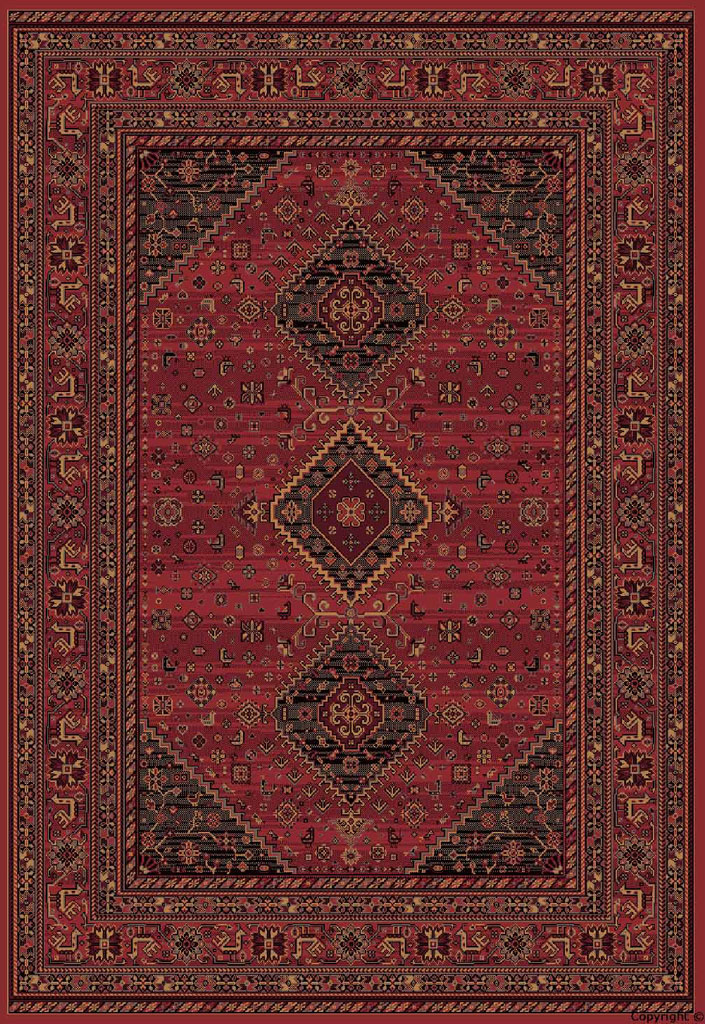
JEWELRY AND RUGS
Afghanistan is a country studded by jewels such as the Timur Ruby Necklace of Badakhshan, tapestries and artifacts that date back to the 2nd century A.D. and people of varying origins. The Imperial State Crown, is beautifully adorned with the Black Prince’s ruby which was mined in Badakhshan province. But the country is not only famous for its rubies, in fact the beautiful and historic Panjshir Valley is rich with some of the most stunning emeralds the world over.
Afghan rugs are among the most renowned in the legacy of art in Afghanistan. These rugs depict deep hues, intricate details and human devotion poured into these fine creations, as is illustrated in the most recent trend of Afghan war rugs.
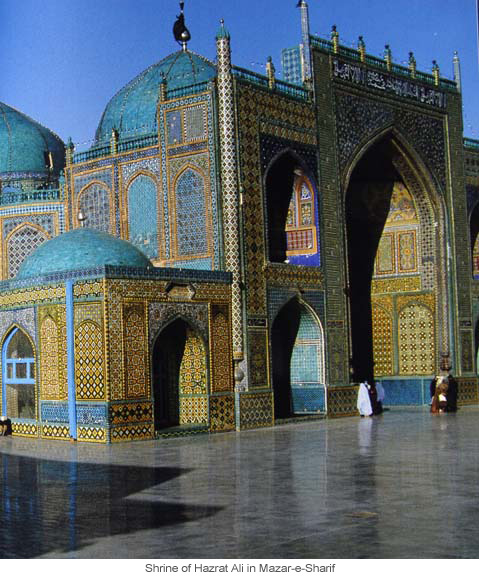

ARCHEOLOGICAL SITES
There is a plethora of evidence that is illustrative of Afghanistan’s rich heritage. Ancient and modern architecture in Afghanistan combines elements from Iran, India, and Byzantium. Mosques, fortresses and minarets reveal the artistic glory of past empires. The best sites to view architectural masterpieces are Herat, Bamiyan, Mazar-e Sharif, Balkh, Ghazni; however, architectural sites are spread throughout the country.
Herat, the pearl of Khurasan is the cultural heart of Afghanistan where dramatic plays and exquisite mosaic art have earned its people an unparalleled reverence for aesthetic beauty as is illustrated by the marvel of the towering mosque in Herat, Masjid Jama with its intricate ceramic tile designs. Mazar-e Sharif (lit. Tomb of the Exalted) in northern Afghanistan is considered by Afghan Shia Muslims to be the final resting place of fourth caliph ‘Ali bin Abi Talib (d. 661 A.H.). Legend contends that the caliph’s body was moved from Najaf to a secret tomb near Balkh. Seljuk sultan Sanjar erected a shrine on this site in 1136, which was probably destroyed in Mongol invasion of 1220. Timurid sultan Husain Baiqara (1469-1506) built the present shrine (Blue Mosque of Hazrat Ali) in 1480-81, furthering to the town’s development into a large urban center. The shrine was restored extensively in the mid-twentieth century and draws pilgrims throughout the year.
Intense efforts are currently being made to preserve Afghanistan’s many historical sites. The Aga Khan Development Network’s Trust for Culture initiatives have focused on conserving and restoring Afghanistan’s cultural heritage while concomitantly stimulating local economic development and improving the quality of life of the people inhabiting the surrounding neighborhoods. AKDN is restoring the Mausoleum of Timur Shah, regarded as the founder of Modern Afghanistan, as well as the historic gardens at the burial site of Bagh-e-Babur who was the founder of the Mughal Empire. AKDN Trust for Culture has also undertaken the restoration in historic neighborhoods of Asheqan wa Arefan in the Old City of Kabul as well as Bar Durrani in the Old City of Herat.
The Kabul Museum is also undergoing extensive renovation. The museum, which once housed the most comprehensive record of Central Asian history, was bombed numerous times throughout the nineties, causing extensive damage to the collection. Despite efforts by the United Nations and devoted museum staff to protect the remaining collection, thousands of antiquities were plundered for the illegal antiquities trade. Today, many of these items are being recovered, as efforts to restore and preserve Afghanistan’s rich cultural heritage continue.<
Tragically, some of Afghanistan’s greatest cultural treasures, such as the Bamiyan giant Buddha statues, were destroyed by the repressive Taliban regime. The unforgettable now-faceless Buddha statues are located in Bamiyan where so many Americans would travel to visit especially in the 1960s. In 2003, in the wake of the Taliban destruction, UNESCO declared Bamiyan a World Heritage Site.

MUSIC
Afghanistan is home to a variety of regional music characteristic of the ethnic groups inhabiting the different parts of the country, though there are many similarities between them. These various ethnicities have close relationships with the music of adjacent countries: Iran, Pakistan, Uzbekistan, Tajikistan and Turkmenistan. Pashtun regional music is of particular importance, forming the basis of radio popular music style. The national instrument is the Rubab, a short-necked lute with sympathetic strings. Long-necked lutes such as Tanbur, Dutar and Dambura are widespread and favored by the Uzbeks and Tajiks, as are bowed lutes like the Sarinda, Sarang and Ghaichak. There are, however, very few instrument types which are exclusive to Afghanistan, the Tanbur and 14 stringed Herati Dutar being two exceptions. Women’s domestic music is of great importance. There are genres of song accompanied by the Daireh (frame drum), and the drum is also used to play rhythms for dancing. Another wide spread kind of music is that for sor-na ad dohol (shawm and double-headed frame drum) which has an important role in village wedding festivities for staging processions and for group.

SPORTS
And for fun- Buzkashi is a game that dates back into Afghan antiquity. The name Buzkashi, literally translated means “goat killing” and it was derived from hunting mountain goats by champions on horseback. The coalition troops protecting Afghanistan have mastered this sport! Another activity that is enjoyed by millions of Afghan children is kite-running, which involves competing teams that build and “fight” kites for large audiences. Afghans also play a wide variety of sports familiar to Americans, such as soccer and basketball.
In sum, Afghanistan encapsulates a space filled with beauty, sweetness and serenity where one feels the atmosphere of a civilization that is reclaiming its timeless search for peace in a geographic oasis nestled in song, prose and beauty.